Today we have a guest article by a very talented gunsmith and friend of the site, John Cross. This article was rejected by other publications as being too technical, so it should be right at home here. Thanks, John!
What Makes a Magazine Work?
By John Cross
In the world of self-loading magazine-fed firearms, two main factors govern reliability of operation; ammunition and magazines. In reality, 90% of all stoppages in such arms are magazine related. The particular case in point here is a World War II German MP44 rifle in 7.92x33mm that seemed to be “jamming” to an unsatisfactory level, so I decided to try to find the cause and to remedy it. The problem was the MP44’s continually having two live rounds in the feed way, one being pushed forward by the bolt and the other round resting above it, causing the stoppage. There seemed to be no rational reason for this, as it happens rarely or never with other such guns.
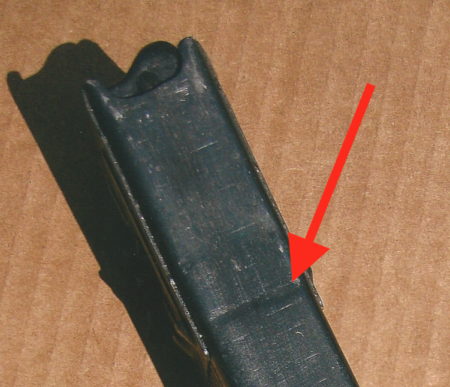
My experience led me to believe that the problem resulted from variations in magazine size and the magazine housing, as the MP44 was made near the end of the war when relative quality control was suffering. The result was a more than usual sloppy fit of the magazines the magazines in the guns. I have seen some that are so loose that they will not function at all and some so tight that they will not go into the magazine well, but by force. Another major fault of the magazine is due to its length and the weight of the thirty rounds of ammunition it holds. During full automatic firing the magazine oscillates back and forth with enough violence that a dent eventually appears in the front of the magazine where the magazine well ends.
Such oscillation and denting is noticeably increased when firing more violent actions such as that of the 7.92x33mm Gustloffwerke carbine (more commonly known as the VG 15), the “last ditch” Volks Gewehr. For this rifle a ten round magazine was recommended. In fact, I believe this was mentioned during the November 1944 monthly meeting between Hitler and Speer.
The large number of sub-contractors making magazines during this time resulted in front-to-rear dimensions of from 2.033in to 2.055in being recorded. The problem could have been mitigated by having a longer magazine housing, such as was tried in the Horn delayed blowback prototype.
Drawing #1 shows the magazine housing in a wartime illustration of the short stroke gas piston initiated, delayed blowback Gerät 06 probably taken from an industry standard. We see from this illustration that the front of the magazine housing has a 458mm radius, and that the width of the housing tapers from 1.212in at the rear to 1.122in at the front, and that it measures 2.063in front to back. The tangent angle is 2.5 degrees over the length of the magazine housing top to bottom.
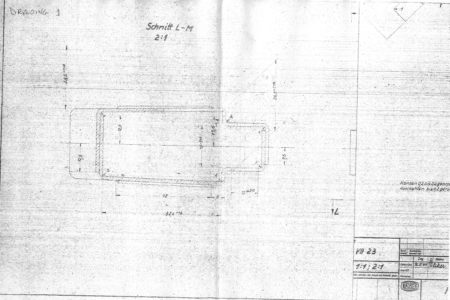
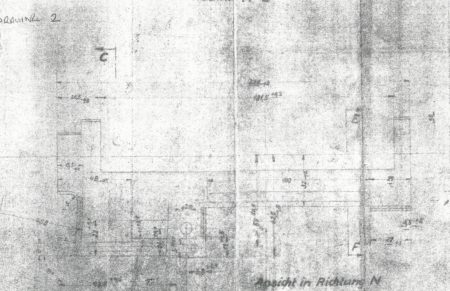
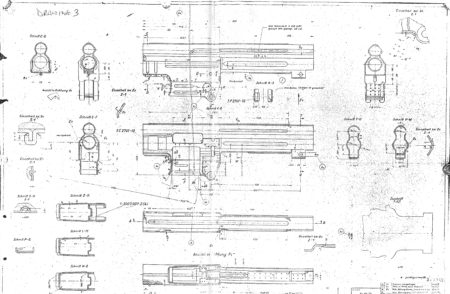
As we can see from Drawings 2 and 3, there is a small difference between the drawings of the magazine housings of the MP44 and the Gerät 06 . That for the MP44 gives a front radius of 460mm, as compared with the Gerät 06 drawing of 458mm, so how was the MP44 magazine designed?
The upper section of the MP44 housing consists of a machined trunnion (drawing #4) that is at the heart of reliability for the rifle. There is no radius of angle in this section; it is perpendicular to the center line of the weapon. Additionally, the fit is longer than that in the drawing of the standard magazine housing, i.e., the width at the rear is 0.008in bigger, the width at the front is standard and the overall length is 0.024in longer than standard. All of this was evidently done to enable the curved magazine to fit into a rectangular shaped housing. The lower part of the housing consists of the correctly radiused receiver pressing at the front and a pressed steel insert at the rear (drawing #5). However, the insert is perpendicular and is not radiused or angled forward by 2.5 degrees. It is spot welded into the magazine well presumably against a machined and radiused solid steel gauge, which represents the maximum magazine dimension. This assembly gives an approximation of a continuous curve through a series of straight lines, as opposed to the front of the body pressing that is curved.
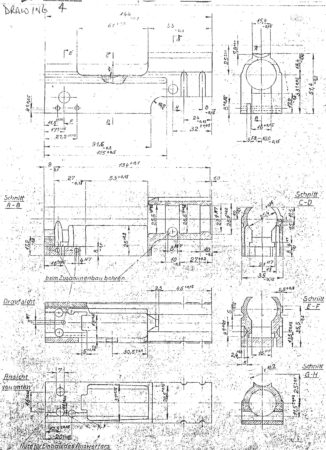
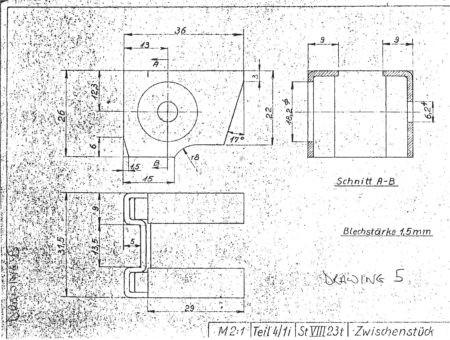
To test this theory I built a device having a facsimile bolt of the 06 type and a magazine housing of standard length wherein the angle of the housing relative to the bore centre line could be changed, as well as the height of the magazine relative to the centre line of the action (photo 1).
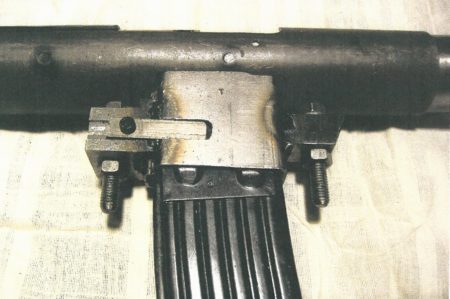
The device enabled me to replicate the stoppage which was caused by the front of the top cartridge in the magazine being turned in when the feed horn of the bolt passed over the cartridge’s rim during the rearward movement of the bolt. This round did not jump out, but remained in the position shown (photo 2).
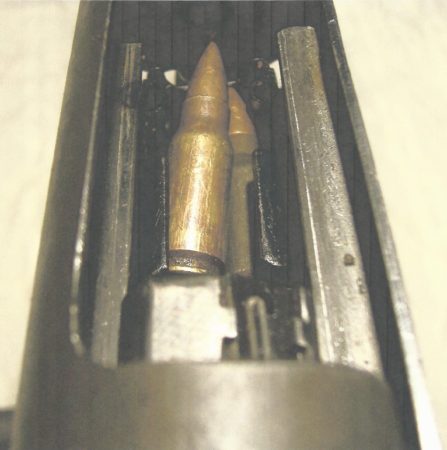
Normally this would not matter, as the cartridge would be fed into the chamber when the bolt moved forward. However, if the firearm was excessively jarred by the bolt carrier violently hitting the rear of the receiver, the skewed cartridge would more likely jump out of the magazine and cause a stoppage. Such an excessive jarring could be caused when the magazine was nearly empty and thus providing less friction against the bottom of the bolt, or by other causes. Such a more violent jarring occurs constantly in actions like that of the VG15, but not so much in the MP44 because of the generous 3.5in rear over-travel of the bolt past the rear of the magazine¹. However, I felt that I still did not have the whole answer as to why some MP44’s suffer from the feed problem and some to not.
A steel sheet measuring 2.056in x 13.5in was prepared, which fits in any MP44 magazine housing, and becomes in effect the tangent angle of the housing. This was used with a pressed sheet with an edge to sit on the MP44’s cocking handle slot (which is parallel to the barrel). In this way the angle of the MP44 magazine housing could be measured by the angle between the two sheets. A difference of 0.186in at the end is equal to one degree. If the housing is manufactured correctly the tangent angle should be 2.5 degrees.
The following results were obtained:
MkB42(W): 2 degrees
MP43/1 a series: 1 degree
MP43/1 c series: 2 degrees
MP43 cos/fxo: 1 degree
MP44XE: 1 degree
StG44byf: 0 degrees
MP44 cos/ce: 1 degree
VG15: 2 degrees
Gerät 06(H): 2.25 degrees
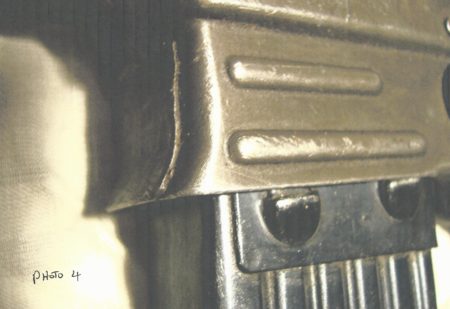
Using the facsimile action the housing was changed from 3 degrees to 0 degrees and the bolt was pulled backwards. The nearer to 0 degrees the more often the top round in the magazine was skewed sideways. The magazine worked best at 2 to 2.5 degrees. Next I tried changing the height of the housing relative to the centerline of the action.
To work properly and have an adequate feed horn to top round overlap the feed horn had to protrude into the magazine 0.220in, but 0.240in was better (see drawing #7). Secondly, when the magazine housing was set at 0 degrees the skewing of the top cartridge was lessened by lowering the housing to obtain a smaller overlap between the feed horn and the top of the cartridge rim. I believe this is why the Gustloffwerk carbine has a very small overlap of about 0.050in.
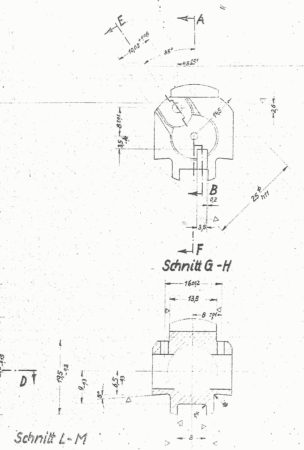
So, the question is, were the wartime designers aware of all this? I believe that they were for two reasons; firstly because the gap between the magazine feed lips was decreased on an average of from 0.530in on early magazines to 0.49in on later ones (although there are exceptions). Decreasing the gap improved the problem of cartridge skewing, but the front to back measurement of the magazine tended to increase as the war progressed, and most post war manufactured magazines follow this trend. The real answer to the problem of magazine fitting is not to use a magazine housing, but to have machined steel front and rear attachments, such as in the AK. This also solves the problem of the magazine oscillating during firing.
After the war Schmeisser, Horn, Barnitzke and other small arms designers went to work in Russia, to presumably work on the AK. I suspect that the AK magazine was their work reflecting the problems encountered with the tolerance difficulties of the MP44 and its magazine. I hope that from this study we have achieved verisimilitude on some aspects of magazine design, as well as subtle difficulties that can be associated with it. I encourage you to investigate for yourselves.
¹ While this generous over-travel distance is intended to give the magazine sufficient time to lift the stack of cartridges for feeding, it also results in very smooth and controllable full automatic fire. Many other designs including the FN, M16 and AK have significantly shorter over-travel distances, which cause more disruptive recoil impulse to be transmitted to the firer’s shoulder when the bolt decelerates abruptly at the end of its travel.

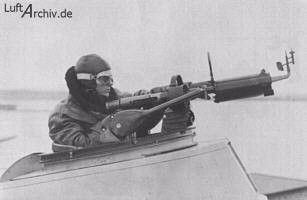
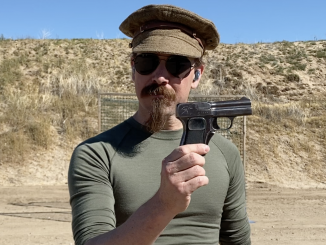
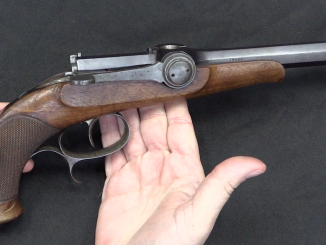
Many of the bolt cycling features of the MP43 were later built into the Singapore Ultimax 100. When I see high speed video of the MP43 being fired on Youtube, it looks like the bolt does not strike the rear of the receiver, making the operating cycle similar to the Ultimax’s ‘constant recoil’cycle. The only thing missing is the Ultimax’s open bolt firing, which I believe the first 5,000 MP43’s had, but was taken out.
The long bolt travel has a series of cascading advantages besides more time to let the magazine function, reduced recoil, and controlibility. The whole mechanism has more time to function, less stress/ banging on the sheet metal parts, reduced cyclic rate which makes the magazine load last longer, and a longer heat buildup cycle due to firing firing.
Sorry about al the typos in my message, I’m subject to migraines that makes my vision go bad so it’s hard to proofread when it happens.
Jim
This is an absolutely fantastic piece, but a shame to hear about the migraines. I’d be willing to proofread for you if you’d like.
“long bolt travel has a series of cascading advantages”
But it require more space, so make weapon bigger and heavier.
Also with gas-operated weapons lower rate-of-fire might be achieved without that.
Absolutely fascinating topic! If Mr. Cross has time and the inclination, this would make a fine regular feature.
That’s a very informative, well-written article, reminiscent of the kind that often graced the pages here in the early days of Forgotten Weapons, so in a sense it’s kind of a nice “blast from the past.”
A bit off-topic … but over the last dozen years or so, there seems to have been a huge shift on the internet from written content to online video, leaving an ever-increasing chunk of “the internet” basically hidden behind a wall invisible to search engines. It’s an even greater challenge when trying to research something in a foreign language when all that exists is video (which must undergo two layers of translation). So the much-celebrated technological “advancement” from written text to video content has been in many ways a big step backward. (OK, daily rant over)
That’s why some sites post a transcript along with the video. Presto, back to being searchable.
Hi
If John Cross or other reader can help me answer two questions I would be most grateful:
1. What is the spring constant (N/mm) of STANG magazine spring?
2. What is the initial force the spring apply on the follower of STANG magazine when the magazine is empty?
Thank you
Excellent article. Explains a complicated matter in a language easy to understand.
From what I saw in German archives, keeping down cyclic rate had a high priority. I believe this is the main reason for the long overtravel.
Even thought HMG is using a STANG magazine well in there STG-N I wonder if some of the same issues have caused the repeated delays in there release? Going to post this on there Facebook page with that same question.
What a great post, I have had an MP43/1 and an MP44 for sometime but learned more about the magazines for them in this post than in usage over the years. Thanks Harry
Thank you ! I have a new to me MP44, this may help sort out issues I’m having with Numrich mags. My WWII mags are still function smoothly.
Grabbing the MP40 or the STG-44 by the magazine tends to cause jams a lot. Supposedly the magazine well is a good grip, but amateurs tend to grip the magazine instead. For the PPSH-41, holding the magazine was likely the only way for one’s off hand to stay clear of the reciprocating charging handle. And the dexterity orientation can get iffy depending on design. Does one change magazines and rack the bolt with the right hand or the left hand? Both actions are generally done by the same hand, so where does one keep ammunition pouches on his person? Did I mess up?
As we have learned to expect from the redoubtable Mr. Cross, a masterful explanation.
The problem begs for a user-doable remedy. If it is (precariously) assumed that the magazine is optimally positioned when all four stops are firmly resting against the bottom edge of the magazine well (contra photo 4), it invites experimentation with shimming the rear wall of the magazine to remove the slop and determine its effect on feeding reliability.
M
Dear All,
The most important course of action is that when choosing a MP44 make sure that
all four magazine stops contact the magazine housing. Also do not assume that
when a mag does not work correctly there is a gun problem,it is usually a sloppy,undersize mag
“In fact, I believe this was mentioned during the November 1944 monthly meeting between Hitler and Speer.”
Why would you believe such thing? Quite an elaborate belief.
“After the war Schmeisser, Horn, Barnitzke and other small arms designers went to work in Russia, to presumably work on the AK.”
Looking for well paying job offerings after their ideology was destroyed???
Even without reading their biographies, I dare to disclose my belief for the verb “went” being a bit wrong choice.